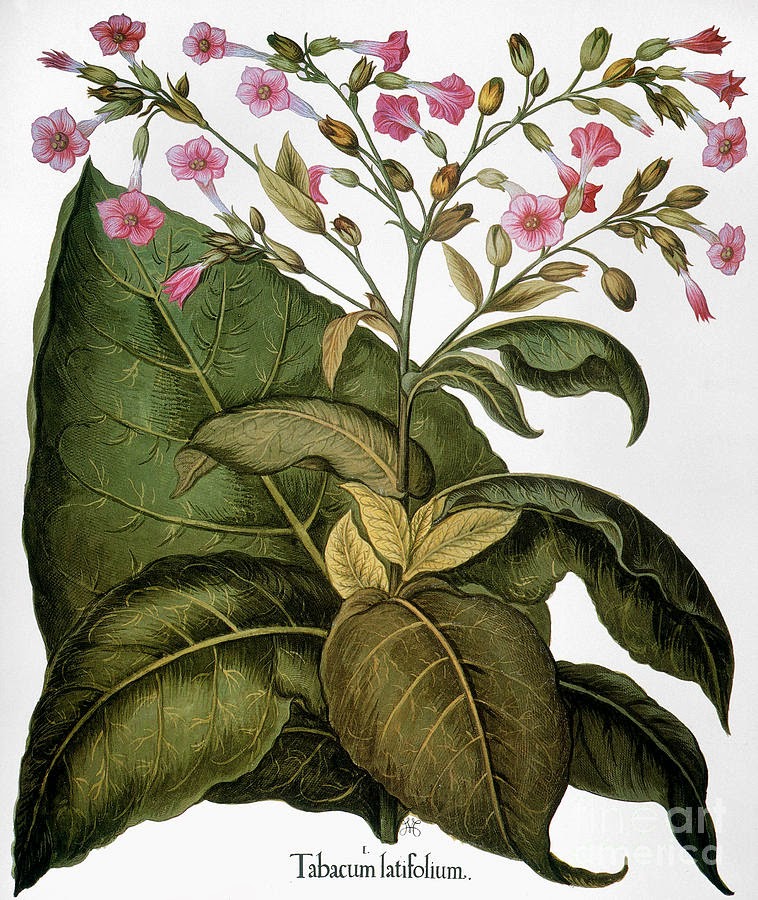Tobacco Cultivation

A teaspoon of tobacco seeds was enough to plant six acres. The seeds were started in a seedbed, then the seedlings transplanted to mounds spaced like those for corn over a roughly cleared field. Both corn & tobacco required similar handling-hoeing down weeds, picking off bugs, chopping the stalk at harvest time & allowing the tobacco leaves or corn kernels to dry. The next year, the planter simply chose another spot, a few feet away, & repeated the routine. After a few seasons, however, planters would have noticed their plants were less robust than at first, & generally, that the plants produced less per field. This decline led farmers to think that the crop had depleted the soil of nutrients, leading to its "exhaustion."
More than a century before Maryland's founding, the Spanish cultivated the Mayans' drug plant, tobacco, in the West Indies. It was grown in France by the mid-1550s, & in China, Japan, & South Africa before the settlement of Virginia. Farmers in England grew tobacco legally until 1619 (& illegally afterward), when a law aimed at generating import duties gave the Virginia Company a virtual monopoly of the market. By 1634, Virginia had been a royal colony for a decade, & nothing prohibited Maryland farmers from entering the profitable tobacco trade from their start.
Cartouche Shipping Hogsheads of Tobacco from Frye-Jefferson map of Virginia, 1755. Farmers responded by letting "old fields" "rest" for up to twenty years. In order to keep producing tobacco, growers moved to new fields, thus using up more & more land & deserting exhausted fields. Over decades, this practice made for a forlorn-looking landscape & tagged tobacco growers with the reputation of being slovenly & unskilled farmers at best, & rapacious at worst. "Soil exhaustion," actually caused by microbes, also figured in arguments over slavery & for agricultural reform.
For most of the 17th century, tobacco held complete sway over Maryland agriculture. When prices were high, little else mattered; when prices fell, even ruinously, growers simply awaited a reversal of fortune. Rather than building fences, improving meadows, & storing up winter feed, as good livestockmen knew to do, tobacco planters and their servants, both men and women, simply let the animals run in the woods to fend for themselves, or, at most, grew an orchard for their scrounging. Because nothing else earned as much money per acre as tobacco, the "sotweed" remained the mainstay of Maryland agriculture for better & worse. The first black slaves arrived in Virginia in 1619, & in 1660, only 3% of the colonists were black. Until the early-mid 1700’s, white convicts & voluntarily indentured white people, male and female, formed a greater part of the tobacco workforce. And until something else offered a similar opportunity for wealth, or even a living, tobacco dominated Maryland's agricultural practices & economy.
As early as the 1600’s a number of physicians began to note that heavy smoking of tobacco in pipes appeared to be associated with an increased risk of oral cancers. The German surgeon Samuel Thomas von Smmerring (1755-1830) voiced concern over the apparent link between lip cancer & pipe smoking in 1795. Others had made similar observations including the apparent correlation between the location of cancerous tumors of the lip & mouth & the side of the mouth that smokers were accustomed to holding their pipe.
English surgeon Sir Percivall Pott (1714–1788) began to investigate cancer in the mid 1700’s & discovered that chimney sweeps had an increased rate of scrotal cancer. His investigation into other cancers in chimney sweeps & other professions indicated that cancer could have environmental triggers. Pott concluded that soot & smoke were directly linked to an increase in cancer risk & as such, he became concerned over the health effects of smoking tobacco. Although Pott was the first to formally investigate the association of soot & smoke with cancer, the fact that chimney sweeps appeared to be at higher risk was noted as early as 1602.
In 1761, English physician John Hill (c 1716-1775), who was often called a quack doctor & quarreled with the Royal Society made the first formal investigation into tobacco usage & cancer. He noted the increased incidence of oral & nasal cancer in both tobacco smokers & users of snuff. In his report Cautions Against the Immoderate Use of Snuff he stated “snuff is able to produce swellings & excrescences in the nose, “and he believed these to be cancerous."
Dr. G. Terry Sharrer



